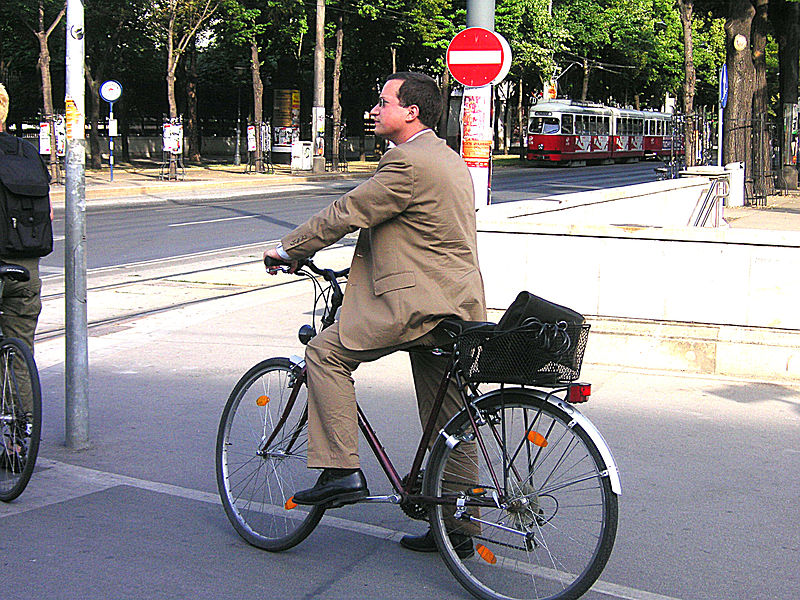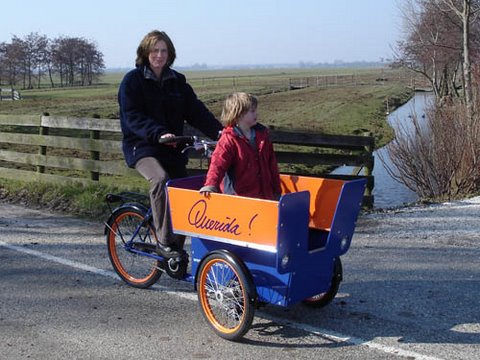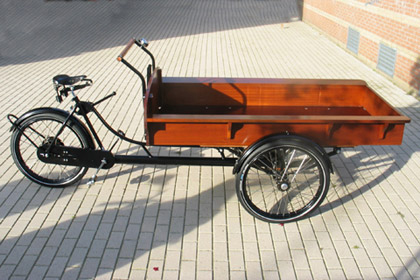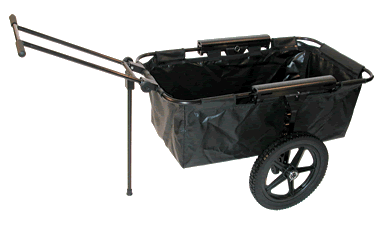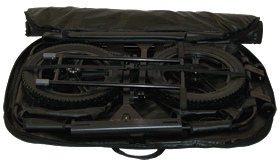Using a mounted (stationary) bicycle to generate electricity has been around for some time, as has using bicycles to power bicycle accessories, particularly lights. A new technology enables charging various devices while still using a bicycle for transportation. If this can evolve into a reliable means for charging communications devices and, say, flashlights, we’d have one more means of keeping things going during power failures.
Category Archives: Bicycles
London To Create Unbroken Network of Bike Routes
Bicycle Commuting, lowers CO2 emissions, and is healthy for the commuter. Gwyn Topham, transport correspondent for The Guardian, reports on London’s ambitious plans to encourage bicycle use.
An unbroken network of cycle routes with some Dutch-style segregated lanes has been pledged as part of a £913m 10-year plan to make London safer for cyclists – including an east-west superhighway dubbed “Crossrail for the bike”.
The versatile potential of bicycles and trikes: two galleries
These speak for themselves, for the most part. But it might be worth noting that none we’ve noticed have electric assist, either by hybrid electric or solar electric, which are both, we believe, in limited use around the world.
From FrogMob, the mob-sourced section of the FrogDesign Blog ((From the reknowned design firm FrogDesign – where they design everything except frogs)), Work Bikes:
[slideshow id=92]
From the Cool Tools section of Kevin Kelly’s site, kk.org:
This is only one of nine variations of the Free Radical Conversion kit. See that – and bicycles with cargo carrying included, at XtraCycle.
Cool Tools also has great suggestions about bicycle repair tools, and other modifications. Check their Autonomous Motion section, their Bikes/Trikes subsection of their Street Use archives for more work bike info, including Velowalla, an archive of bike/trike use for business in India.
Questions on Sustainability and Human Ecology, Part 2.
Observations on society and civilization
Part 2 in a series.
John Muir once told Edward Harriman that he was “wealthier” because while he had much less money, he knew exactly how much he needed to live comfortably. Stepping back and looking at society and civilization from the perspective of a John Muir …

Aerial view of northern Manhattan, showing the Jackie Onasis Resevoir, Central Park, the Upper East Side, the Upper West Side, and southern Harlem.
I commute, on a daily basis, to a job in New York City, some 45 miles north of my home in New Jersey. This commute is accomplished via car and bus, at an average speed of 30 miles per hour. If I was to I leave my home at 6 AM, and travel as Thoreau might suggest, by walking, I could cover the distance in 15 hours, and arrive at 9 PM. This would not be practical, since the purpose is to arrive, work, and go home, not travel, enjoy the sights, and learn. I could make the trip on a bicycle in 3 to 4 hours. While bicycling 6 to 8 hours each day would be terrific cardiovascular exercise, this would not be practical in conjunction with the need to work 8 hours per day. The cars and buses are heated and air conditioned, so I and other commuters are comfortable year round, despite the air conditioning that is so cold that in the summer that we need sweaters, the heat that is so hot that in the winter we perspire, and the traffic that cuts our average speed from 50 or 60 mph to 30 on a good day.
During my commute I read, sleep, listen to music, write, or work. I can be productive with a laptop computer or hand-held cellphone, email device, or book. Sometimes I non-productively talk to strangers I encounter on the way. Continue reading
Human-Powered Monorail
This has many of the advantages of bicycles – and several more:
- resistant to weather –
- because they’re on a predefined, car-free path, bicycle/vehicle accidents seem highly unlikely (assuming the routes are planned reasonably);
- the bicycle theft problem which plagues bicycle-friendly cities like Amsterdam seems unlikely to be a problem.
– and in turn via TreeHugger.
From Jorge Chapa’s post on Inhabitat
What could be more fun than gliding along on an eco-chic bicycle
? How about shooting through the skies in a pedal-powered monorail capsule! A bunch of entrepreneuring New Zealanders has created just such a human-powered monorail system, known as the Shweeb. Their creation does double duty, acting not just as an innovative transportation system, but also an amusement ride. Are our cities the next step?
The technology behind the Shweeb is remarkably simple – the only infrastructure required is a network of interconnected single rails. A number of pods are hung from this these lines, which are powered by the people sitting inside them. In principle, these pods are no different than recumbent bicycles – they can achieve close to 25 mph, are comfortable to use, and can be used by nearly anyone.
Although we don’t expect to see cities connected by pedal-powered monorail systems anytime soon, there are a number of applications where they could be useful. Think of guided tours through natural parks, scenic routes, adventure camps, and developments that require large pieces of land and a reasonable amount of population.
For now the system is in use on Schweeb’s grounds in New Zealand. If you are feeling adventurous, feel free to visit them at Ngongotha, New Zealand.
As noted above, Via Inhabitat – and in turn via TreeHugger.
8th grader builds four-passenger-plus cargo solar/human powered bicycle
If an eighth grader can do it – albeit an exceptional eighth grader – why can’t they be mass-produced at affordable prices?
8th Grader Builds Solar-Powered Bike With GPS, iPod Dock
The base vehicle used, and the priciest part of the project, was a Switzerland-built ZEM (Zero Emission Machine) 4cycle. It’s made out of an aluminum frame
and each rider can pedal at their own pace. In fact, the 4cycle took 3rd place at the human powered vehicle world championships at Interlaken, Switzerland.
And while the ZEM 4cycle is no longer produced, they got one from a dealer in Maryland who purchased the last 3 from the US distributor. It cost them $3,900.
“[The SOHH] has replaced our cars for errands around town, and it has grown into more than we envisioned with a lot of interest from the community,” David Dixon Sr. told Wired.com
.
And for the win, they documented the project on their website with all parts and schematics so that anyone can build one. They don’t plan to mass produce the vehicle but would love it if someone else does. Though David Sr. did express an interest in updating the bike with a lighter battery “such as lithium polymer, but no budget for it yet.”
[imagebrowser id=85]
Sources: Wired.com , The SOHH Project and Gas 2.0 .
Daniel Bauen. "Instructables" – and the symbiosis of art and engineering
Given our cultural separations – “artists” in one place – “engineers” another – many of us – I’m guilty of this frequently – we forget how intertwined, and sometimes indistinguishable they are. Rather than make the general argument, check out Daniel Bauen, a young Atlanta-based maker and designer of things. You can look at his resume – and some brilliant pieces of work. If anyone thinks they can draw bright lines between the art and the engineering, we might have an interesting discussion. What’s beyond question is that he’s doing marvelous work. Beautiful, practical – and some so fun that I’m tempted to say that he’s a toymaker – who, in order to make what he makes – became an engineerand an artist in the process.
A motorized moving shade system for buildings – that is, roof-mounted solar panels move automatically in order to maximize shade and solar collection: (pictured left); A solar rock spinner – solar-powered when none one feels like pushing it around;
Bauen also – as a student – participated in the design of two bood-drawing devices one for pediatric and one for diabetics, designed to alleviate, if not eliminate the pain of blood drawing.
There’s more at Daniel Bauen’a personal site and even more at his other site- Engineerable. Continue reading
Patrick McGeehan, NYT: A Bikes-Only Parking Lot in Midtown?
of the Times City Room Blog
reports that
A few business executives have dreamed up a private-sector solution to the problem of secure bicycle parking in New York: the city’s first bikes-only parking lot. They have a space on West 33rd Street. All they need is a corporation willing to pay as much as $200,000 a year to sponsor it.
“We’re really looking for a big number to build something quite spectacular,” said Daniel A. Biederman, president of the 34th Street Partnership. “We want this to be the premier bike parking facility in the country.”
Already, the group has cleared one high hurdle: Stonehenge Management, a developer, has offered a 2,600-square-foot lot next to an apartment building it owns on the north side of 33rd Street between Eighth Avenue and Ninth Avenue, Mr. Biederman said.
The partnership, which is financed by businesses and property owners in a 31-block section of Midtown, has developed a preliminary design for the lot and has ordered up a prototype of the racks it would contain, Mr. Biederman said. At first, it would hold 100 bikes, with room to expand if there is more demand, he said.
A Bikes-Only Parking Lot in Midtown?
US Bike Sales Rising With Gas Prices | BikeRadar.com
Richard Peace of Bike Radar reports:
Numerous bike retailers in the United States are reporting a spike in sales on the back of the seemingly inexorable rise of gas prices at the pumps throughout the country.
In particular bike retailers are reportedly noticing a strong rise in commuter cycling queries — unusual in a market that is regarded as primarily a leisure and sports-based one. Recently the price at the pumps hit $3.60 a gallon and the net is full of reports from bike shops across the US noting the price squeeze effect on customers coming through their doors.
“We’re getting more and more customers that are buying bikes to commute in lieu of gas prices,” said Jarvis Polvado of the Texoma Cycling Centre in Wichita Falls, Texas. “Where I’ve seen the biggest increase is people buying bikes to go to work.”
“Everyone that comes in the shop is talking about the gas prices,” said Barry Dahl of Barry’s Bikes in Bismarck, North Dakota.
“People are using their bikes a lot more today for transportation purposes,” added Ken Hartley, owner of Hartley’s Cycle Shop in Hinsdale, Illinois. “We’re selling more racks, we’re selling more fenders, we’re seeing a lot of interest in locks to lock their bikes at the train stations.”
This is, of course, good news, but we think there are other steps in many communities, certainly here in New York: government support for bicyclists, employer-supplied bike racks, and perhaps tax incentives — like an exemption from sales tax on bicycles and relevant accessories (like racks). In many places, bike lanes don’t yet exist. And — as I believe we’ve reported on other occasions — there’s some evidence that there’s a tipping point of bicycle riders — after which automobile drivers start driving to accommodate them. If prices keep rising at current rates, most of these will be demanded, arranged, or get taken care of.
Thanks to our neighbor Joel Johnson of Boing Boing.
Portland apparently a node of the international bicycling conspiracy
would have it, Portland is a hotbed, – not just of big brands (Nike, etc.) –
what is most distinctive about the emerging cycling industry here is the growing number of smaller businesses, whether bike frame builders or clothing makers, that often extol recycling as much as cycling, sustainability as much as success.
Like the local indie rock bands that insist they are apathetic about fame, many of the smaller local companies say craft, not money, is what drives them.
“All the frame builders I know got into this because they love bikes,” said Tony Pereira, a bike builder whose one-man operation has a 10-month waiting list, “not because they wanted to start a business.”
Mia Birk, a former city employee who helped lead Portland’s efforts to expand cycling in the 1990s, said the original goals were rooted in environmental and public health, not the economy.
“That wasn’t our driving force,” Ms. Birk said. “But it has been a result, and we’re comfortable saying it is a positive result.”
Ms. Birk now helps run a consulting firm, Alta Planning and Design, which advises other cities on how to become more bicycle-friendly. In a report for the City of Portland last year, the firm estimated that 600 to 800 people worked in the cycling industry in some form. A decade earlier, Ms. Birk said in an interview, the number would have been more like 200 and made up almost entirely of employees at retail bike stores. Continue reading
In Copenhagen Bicycles Overtake Cars (via EcoProfile and TreeHugger)
April Streeter has this in yesterday’s Treehugger:
As a result of half a century of planning, Copenhagen has achieved a fabulous cycling goal – during the morning rush hour more bikes and mopeds pound the inner city streets than personal cars and buses. Just a bit more than a third of inhabitants get to work by bike every day – the other two thirds take public transport or a personal car. But the news gets even better – Copenhagen’s municipal government is increasing spending to improve bike lanes and paths and the bike travel experience.According to this survey, Copenhagen is behind places such as Amsterdam (where a claimed 40 percent of traffic moves by bike) and Portland, Oregon in providing the best inner-city biking experience. This may be true, but Copenhagen has got to be the stylish bike capital – especially with the bloggers at copenhagengirlsonbikes and cycleliciousness making it look so cool to ride.
City officials now want to increase cyclists to make up half of all commuters by 2015, as well as increase cyclists’ speeds by 10 percent while reducing the risk of injury. How will they do it? Partly by investing more – they added about 25 million Danish crowns (US$ 3.7 million) in 2007 to the yearly budget of 75 million crowns.
Already in the city, subway stops and other open spaces sport large bicycle parking stalls – the best are the covered double-decker stalls – and the city will build even more of these to encourage cyclists to park away from pedestrian and other traffic. They’ll also widen lanes to accommodate more bikes.
In addition, some heavily-trafficked lanes will sport a new bicycle pictogram to show that they get a special ‘green wave’ – traffic lights will be coordinated so cyclists who maintain speeds of about 20 kilometers/hour can just keep on moving.
Across Öresund in Sweden cyclists are not quite so pampered, but some good things are happening – in Gothenburg cyclists will soon be able to use the same Internet service cars have long had access to to create individual bike destination maps for all locations in the city. Via ::Ecoprofile
Update: Colville Andersen – of cycleliciousness notes in a comment to TreeHugger:
Great post. Thanks for the big up about our blogs.
One thing, however, the “survey” you link to is not a survey at all… it’s a commercial website writing a opinion piece about bike cities, without any real research.
Love the treehugger world. Keep up the good work.
Things with wheels that can be used to transport people and stuff.
We’ve been thinking about this a bit: perhaps part of the standard inventory for CERT teams should be a few cargo bicycles or carts that can be pulled by bicycles – or by people. (It’s hard to find donkeys and burros in our part of Brooklyn).
Here’s a design from the Netherlands:
Here’s a link to the U.S. importer. They’ve got a number of other models, too.
Here’s cart – other models of this product are in use by the U.S. military – they’ve got one that supports a stretcher – check out how compactly it stores:
And here it is folded up:
Link to the Charlie’s Horse Deployment System.
We’re going to see if we can find them in use locally and see how they hold up.

